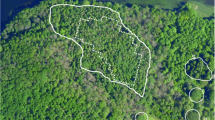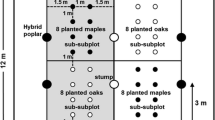Abstract
The goal of this study was to develop management strategies favouring establishment and survival of holm oak (Quercus ilex L.) and downy oak (Quercus pubescens Willd.)—two species co-occurring in Southern France—in mature Allepo pine forests (Pinus halepensis Mill subsp. halepensis). An experimental design was assessed in a partially cut mature stand of Aleppo pine in which five soil and vegetation treatments—chopping, chopping followed by scarification in one or two directions, prescribed burning, control—and two slash treatments (presence/absence) were applied. A total of 1,600 sowing points, each composed of 3 Q. ilex or Q. pubescens acorns, were installed in the different treatments in November of two consecutive years at 6 and 18 months, after the end of treatments. Survival was monitored 3 and 2 years after sowing, soil surface at the sowing points was characterized at different dates, and predawn leaf water potentials were measured during the dry season. High mortality occurred after the first summer, but survival after 1 year was 2.3–5.2 higher in Q. ilex than in Q. pubescens, confirming that Q. ilex was better adapted to the drier parts of the Mediterranean area. Survival was significantly influenced by the treatments, but there was a variable response between the two sowing years under most of the treatments. Only intense fire proved the most beneficial treatment for seedling survival in both years. The micro-local soil cover conditions induced by the treatments played a major role in explaining oak survival. In particular, grass cover (mainly Brachypodium retusum) proved to be largely unfavourable to seedling survival and growth, and this detrimental effect was also confirmed by lower predawn leaf water potential values with increasing grass cover. Acorn introduction designed to diversify mature Aleppo pine forest after soil and vegetation treatments therefore has to be considered for treatments that most efficiently impair the pre-existing competing grass cover such as prescribed high-intensity fire treatment.






Similar content being viewed by others
References
Acherar M, Rambal S, Lepart J (1991) Evolution du potentiel hydrique foliaire et de de la conductance stomatique de quatre chênes méditerranéens lors d’une période de dessèchement. Ann Sci For 48:561–573
Aussenac G, Valette JC (1982) Comportement hydrique estival de Cedrus altlantica Manetti, Quercus ilex L. et Quercus pubescens Willd. et de divers pins dans le Mont Ventoux. Ann Sci For 39:41–62
Barbéro M, Quézel P, Loisel R (1990) Les apports de la phytoécologie dans l’interprétation des changements et perturbations induits par l’homme sur les écosystèmes forestiers méditerranéens. For Médit 12:194–215
Braun-Blanquet J (1936) La forêt d’yeuse languedocienne (Quercion ilicis). Monographie phytosociologique. Mémoires de la société d’étude des sciences naturelles de Nîmes no 5, communication no 40 de la Station Internationale de Géobotanique Méditerranéenne et Alpine, Montpellier, 147 p
Castro J, Zamora R, Hódar JA (2006) Restoring a Quercus pyrenaica forest using pioneer shrubs as nurse plants. Appl Veg Sci 9:137–142
Caturla RN, Raventós J, Guàrdia R, Vallejo VR (2000) Early post-fire regeneration dynamics of Brachypodium retusum Pers. (Beauv.) in old fields of the Valencia region (Eastern Spain). Acta Oecol 21:1–12
Clary J, Savé R, Biel C, De Herralde F (2004) Water relations in competitive interactions of Mediterranean grasses and shrubs. Ann Appl Biol 144:149–155
Damesin C, Rambal S (1995) Leaf study of leaf photosynthetic performance by a Mediterranean deciduous tree (Quercus pubescens) during a severe summer drought. New Phytol 131:159–167
Damesin C, Rambal S, Joffre R (1998) Co-occurrence of trees with different leaf habit: a functional approach on Mediterranean oaks. Acta Oecol 19:195–204
Darley-Hill S, Johnson WC (1981) Acorn dispersal by blue jay (Cyanocitta cristata). Oecologia 50:231–232
Daskalakou E, Thanos CA (1996) Aleppo pine (Pinus halepensis) postfire regeneration: the role of canopy and soil seed banks. Int J Wild Fire 6:59–66
De Luis M, Raventós J, Cortina J, Gonzalez-Hidalgo JC, Sánchez JR (2004) Fire and torrential rainfall: effects on the perennial grass Brachypodium retusum. Plant Ecol 173:225–232
Garonne B (1970) Sur l’emploi de quelques méthodes statistiques pour l’étude de la sociologie et de l’écologie végétales. Application aux formations ligneuses d’un transect allant de Montpellier aux basses Cévennes. Thèse Univ. Montpellier, 131 p
Gómez J (2004) Importance of microhabitat and acorn burial on Quercus ilex early recruitment: non-additive effects on multiple demographic processes. Plant Ecol 172:287–297
Gómez-Aparicio L, Gómez JM, Zamora R, Boettinger JL (2005a) Canopy vs. soil effects of shrubs facilitating tree seedlings in Mediterranean montane ecosystems. J Veg Sci 16:191–198
Gómez-Aparicio L, Valladares F, Zamora R, Quero JL (2005b) Response of tree seedlings to the abiotic heterogeneity generated by nurse shrubs: an experimental approach at different scales. Ecography 28:757–768
Gómez-Aparicio L, Pérez-Ramos IM, Mendoza I, Matías L, Quero JL, Castro J, Zamora R, Marañón T (2008) Oak seedling survival and growth along resource gradients in Mediterranean forests: implications for regeneration in current and future environmental scenarios. Oikos 117:1683–1699
Gordon DR, Welker JM, Menke JW, Rice KJ (1989) Competition for soil water between annual plants and blue oak (Quercus douglasii) seedlings. Oecologia 79:533–541
Harrington GN (1991) Effects of soil moisture on shrub seedling survival in a semi-arid grassland. Ecology 72:1138–1149
Jactel H, Menassieu P, Vetillard F, Gaulier A, Samalens JC, Brockerhoff EG (2006) Tree species diversity reduces the invasibility of maritime pine stands by the bast scale, Matsucoccus feytaudi (Homoptera: Margarodidae). Can J For Res 36:314–323
Jensen TS, Nielsen OF (1986) Rodents as seed dispersers in a heath-oak wood succession. Oecologia 70:214–221
Jiménez MN, Fernández-Ondoño E, Ripoll MÁ, Navarro FB, Gallego E, Lallena AM (2007) Influence of different post-planting treatments on the development in Holm oak afforestation. Trees 21:443–455
Knoop WT, Walter BH (1985) Interactions of woody and herbaceous vegetation in a southern African savanna. J Ecol 73:235–253
Maestre FT, Bautista S, Cortina J, Bellot J (2001) Potential for using facilitation by grasses to establish shrubs on a semiarid degraded steppe. Ecol Appl 11:1641–1655
Maestre FT, Cortina J, Bautista S (2004) Mechanisms underlying the interaction between Pinus halepensis and the native late-successional shrub Pistacia lentiscus in a semi-arid plantation. Ecography 27:776–786
Martínez-Sánchez JJ, Ferrandis P, de las Heras J, Herranz J (1999) Effect of burnt wood removal on the natural regeneration of Pinus halepensis after fire in a pine forest in Tus valley (SE Spain). For Ecol Manag 123:1–10
McCullagh P, Nelder JA (1989) Generalized linear models. Chapman and Hall, London
Nathan R, Ne’eman G (2004) Spatiotemporal dynamics of recruitment in Aleppo pine (Pinus halepensis Miller). Plant Ecol 171:123–137
Nathan R, Safriel UN, Noy-Meir I, Schiller G (1999) Seed release without fire in Pinus halepensis, a Mediterranean serotinous wind-dispersed tree. J Ecol 87:659–669
Navarro FB, Jiménez MN, Ripoll MÁ, Fernández-Ondoño E, Gallego E, De Simón E (2006) Direct sowing of holm oak acorns: effects of acorn size and soil treatment. Ann For Sci 63:961–967
Palacios G, Navarro Cerrillo RM, del Campo A, Toral M (2009) Site preparation, stock quality and planting date effect on early establishment of Holm oak (Quercus ilex L.) seedlings. Ecol Eng 35:38–46
Pausas JG, Ouadah N, Ferran T, Gimeno T, Vallejo R (2003) Fire severity and seedling establishment in Pinus halepensis woodlands, eastern Iberian Peninsula. Plant Ecol 169:205–213
Pausas JG, Bladé C, Valdecantos A (2004) Pine and oaks in the restoration of Mediterranean landscapes of Spain: new perspectives for an old practice—a review. Plant Ecol 171:209–220
Pérez-Ramos I, Marañón T (2008) Factors affecting post-dispersal seed predation in two coexisting oak species: microhabitat, burial and exclusion of large herbivores. For Ecol Manag 255:3506–3514
Prévosto B, Ripert C (2008) Regeneration of Pinus halepensis stands after partial cutting in southern France: impacts of different ground vegetation, soil and logging slash treatments. For Ecol Manag 256:2058–2064
Puerta-Piñero C, Gómez JM, Valladares F (2007) Irradiance and oak seedling survival and growth in a heterogeneous environment. For Ecol Manag 242:462–469
R development Core Team (2005) R: a language and environment for statistical computing. R Foundation for statistical computing. R Foundation for Statistical Computing, Vienna. ISBN 3-900051-07-0, URL: http://www.R-project.org
Rey Benayas JM, Espigares T, Castro-Díez P (2003) Simulated effects of herb competition on planted Quercus faginea seedlings in Mediterranean abandoned cropland. Appl Veg Sci 6:213–222
Rey Benayas JM, Navarro J, Espigares T, Nicolau JM, Zavala MA (2005) Effects of artificial shading and weed mowing in reforestation of Mediterranean abandoned cropland with contrasting Quercus species. For Ecol Manag 212:302–314
Rey-Benayas JM (1998) Growth and mortality of Quercus ilex L. seedling after irrigation and artificial shading in Mediterranean set-aside agricultural lands. Ann Sci For 55:801–807
Silvertown JW (1980) The evolutionary ecology of mast seeding in trees. Biol J Linn Soc 14:235–250
Smit C, Den Ouden J, Díaz M (2008) Facilitation of Quercus ilex recruitment by shrubs in Mediterranean open woodlands. J Veg Sci 19:193–200
Tonioli M, Escarré J, Lepart J (2001) Facilitation and competition affecting the regeneration of Quercus pubescens Willd. Ecoscience 8:381–391
Tyree MT, Cochard H (1996) Summer and winter embolism in oak: impact on water relations. Ann Sci For 53:173–180
Urbieta I, Pérez-Ramos I, Zavala MA, Marañón T, Kobe RK (2008) Soil water content and emergence time control seedling establishment in three co-occurring Mediterranean oak species. Can J For Res 38:2382–2393
Valladares F, Pearcy RW (1997) Interactions between water stress, sunshade acclimtation, heat tolerance and photo-inhibition in the sclerophyll Heteromeles arbutifolia. Plant Cell Environ 20:25–36
Vallejo R, Aronson J, Pausas G, Cortina J (2006) Restoration of Mediterranean woodlands. In: Van Andel J, Aronson J (eds) Restoration ecology: the new frontier. Blackwell Science, Oxford, pp 193–209
Acknowledgments
This study was supported by the Region Provence-Alpes-Côte d’Azur and the French Ministry of Ecology (MEEDDAT). The authors are especially grateful to Aude Corbani, Roland Estève, Aminata N’Daye and Willy Martin for data collection and to P. Roche for statistical help.
Author information
Authors and Affiliations
Corresponding author
Additional information
Communicated by C. Ammer.
This article originates from the final conference of the Cost action E47 “European Network for Forest Vegetation Management: Towards Environmental Sustainability” in Vejle, Denmark, 4–7 May 2009.
Rights and permissions
About this article
Cite this article
Prévosto, B., Monnier, Y., Ripert, C. et al. Diversification of Pinus halepensis forests by sowing Quercus ilex and Quercus pubescens acorns: testing the effects of different vegetation and soil treatments. Eur J Forest Res 130, 67–76 (2011). https://doi.org/10.1007/s10342-010-0396-x
Received:
Revised:
Accepted:
Published:
Issue Date:
DOI: https://doi.org/10.1007/s10342-010-0396-x




